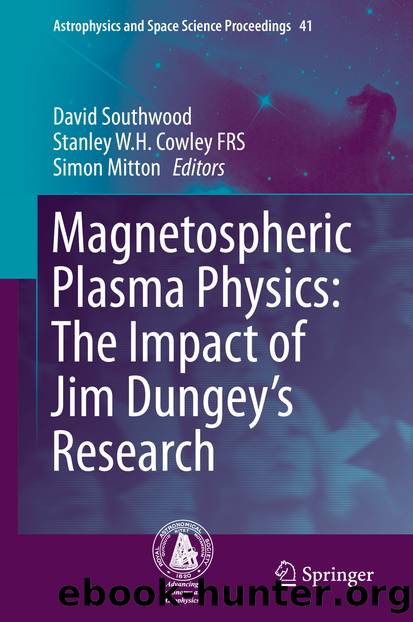Magnetospheric Plasma Physics: The Impact of Jim Dungey’s Research by David Southwood Stanley W. H. Cowley FRS & Simon Mitton

Author:David Southwood, Stanley W. H. Cowley FRS & Simon Mitton
Language: eng
Format: epub
Publisher: Springer International Publishing, Cham
6.1 Introduction
This paper addresses complexity in many-body calculations. Investigation by computer simulation was in its infancy when I was one of Jim Dungey’s students, but is now used in almost all areas of science and engineering. Jim initially pointed me to computational studies looking at non-adiabatic ion trajectories and their effects on currents in the current sheet of the geomagnetic tail (Eastwood 1972, 1974); this is where I first became involved in many-body calculations, using particle methods to model the interactions of plasma with electric and magnetic fields.
Simulation studies face a compromise between the detail of the model and computational resources. In principle classical and pseudo-classical systems may be described in terms of positions, velocities and force laws of the particles of which it is composed. Unfortunately, the vast number of particles involved in quite simple situations generally make such a detailed description computationally impractical, despite the enormous growth in computer power over the past four decades. I learnt from Jim the importance of assessing length- and time-scales and using them to reduce the mathematical models (e.g., as in hydromagnetics and kinetic plasma models). Applying this principle to many-body calculations can lead to models that are sufficiently detailed to reproduce important physical effects but not too detailed to make calculations impracticable.
Even with reduced models, a large part of the computational work in many-body calculations is the evaluation of interparticle forces. For example, given N charged particles, the Coulombic field at one particle has N-1 contributions from the other particles, so to compute fields at all N particles has complexity O(N2). This paper reviews methods of reducing this complexity to O(N log N) in different situations. Reduced to its basics, the problem is to evaluate in O(N log N) operations the convolution sum or integral:
Download
This site does not store any files on its server. We only index and link to content provided by other sites. Please contact the content providers to delete copyright contents if any and email us, we'll remove relevant links or contents immediately.
| Aeronautics & Astronautics | Astronomy |
| Astrophysics & Space Science | Comets, Meteors & Asteroids |
| Cosmology | Mars |
| Solar System | Star-Gazing |
| Telescopes | UFOs |
Turbulence by E. J. Noyes(7039)
Tools of Titans by Timothy Ferriss(6947)
Astrophysics for People in a Hurry by Neil DeGrasse Tyson(4620)
Room 212 by Kate Stewart(4107)
Pale Blue Dot by Carl Sagan(4001)
The David Icke Guide to the Global Conspiracy (and how to end it) by David Icke(3882)
Secrets of Antigravity Propulsion: Tesla, UFOs, and Classified Aerospace Technology by Ph.D. Paul A. Laviolette(3450)
Apollo 8 by Jeffrey Kluger(3200)
Losing the Nobel Prize by Brian Keating(3187)
A Journey Through Divination and Astronomy by Publishing Pottermore(3070)
Goodbye Paradise(2963)
COSMOS by Carl Sagan(2950)
Brief Answers to the Big Questions by Stephen Hawking(2878)
How to Read Water: Clues and Patterns from Puddles to the Sea (Natural Navigation) by Tristan Gooley(2855)
The Five People You Meet in Heaven by Mitch Albom(2843)
The Order of Time by Carlo Rovelli(2714)
How to Read Nature by Tristan Gooley(2665)
A Brief History of Time by Stephen Hawking(2473)
Aliens by Jim Al-Khalili(2382)
